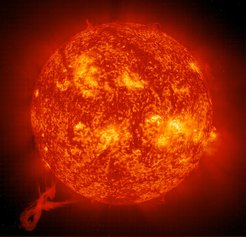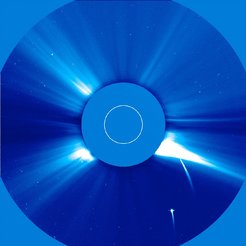Keeps going and going and going ...
The solar observatory SoHO, to which scientists from the Max Planck Institute for Solar System Research have contributed considerably, celebrates its 15th anniversary.
When in1996 during the last days of January the space probe SoHO (Solar and Heliospheric Observatory) deployed its instruments for first solar light, the American and the European space agencies hoped for an operating time of two years. By now, those two years have turned into fifteen – and SoHO into a unique success. SoHO is the oldest operating solar observatory and due to its unusually old age now joins the league of space methusalems such as the Hubble space telescope and the Pioneer and Voyager space probes. Until today, scientific findings revealed by SoHO define how we see the Sun. In particular SUMER and LASCO, instruments with significant contributions of researchers and engineers from the Max Planck Institute for Solar System Research (MPS), keep delivering unique data from our home star.
Equipped with twelve scientific instruments the space probe SoHO was designed to paint for the first time a complete and comprehensive picture of the Sun - from the vibrations deep within its interior to the flow of charged particles, the so-called solar wind, that our star hurls into space. With these new tools, the involved scientists hoped to gain insights for example into the processes within the Sun's atmo-sphere, the so-called corona. 15 years ago it was still largely unclear, why this atmosphere is up to 200 times hotter than the layers underneath. And also the solar wind still held many mysteries: Where does it originate? And how are the particles accelerated into space?

An image of the Sun taken by the instrument EIT onboard SoHO in 2000. SoHO is the only solar observatory that has witnessed this solar maximum. On the left side the picture shows a huge coronal mass ejection.
Thanks to SoHO's measurements researchers have made great progress in answering these questions. Today, scientists distinguish the fast solar wind from the slow solar wind. While the slow particles emanate from the Sun's equatorial region with a velocity of 400 kilometers per second, the fast solar wind originates close to the poles. And also other SoHO observations revealed the Sun as an extremely dynamic star, showed waves and tornados in the corona and for example delivered information about the inner structure of sunspots. These dark patches on the visible surface of the Sun appear more or less frequently on the disk following an eleven-year-cycle.
For studying this periodic behavior SoHO is still extremely useful. SoHO is the only solar observatory that has witnessed an entire solar cycle: the unusually long solar minimum around 2009 and the preceding maximum at the beginning of the millenium. Only SoHO was able to record the solar firework that the Sun offered back then day by day. And if the space agencies NASA and ESA shut down the space probe in 2013 or 2014 as now planned, SoHO would even have experienced two solar cycles.
Despite this success SoHO has recently been rivaled by strong competitors. In October 2006 NASA's mission STEREO (Solar Terrestrial Relations Observatory) began. Two identical probes that watch the Sun from two separate locations like two eyes have been delivering three dimensional images of our star ever since. And since the beginning of last year also NASA's Solar Dynamics Observatory (SDO) has been studying the Sun. With its considerably higher spatial and temporal resolution and a data transfer rate of enormous 1,5 Terabytes per day the younger probe is superior to SoHO in many respects.

"Nevertheless SoHO still provides valuable services", says SUMER-Principle Investigator Dr. Werner Curdt from MPS. One reason is the observatory's unique watching position. At a distance of 1.5 million kilometers from Earth, SoHO orbits the Sun synchronously with the planet. From this vantage point SoHO can watch our star 24 hours a day without interruption. Especially the instrument LASCO (Large Angle and Spectrometric Coronagraph), to which the MPS contributed one of three components, complements the STEREO mission - like a third eye. The coronagraph blinds out the solar disc and thus allows a detailed view of the corona.
Similarly, the instrument SUMER (Solar Ultraviolet Measurements of Emitted Radiation) onboard SoHO remains a valuable source of data for many scientists. The spectrograph that was designed and built under the lead of the MPS and is still operated by MPS-scientists, splits the light from the Sun's atmosphere into its individual components like a prism. This allows scientists to determine the pressure, temperature and flows in the studied area. "At this point, a comparable instrument is not in service - and is not planned in the foreseeable future", says Curdt.
And quite casually, in the past 15 years SoHO has set a second, rather unplanned record: The observatory has become the most successful comet finder of all times. As of December 26th 2010, 2000 comets were found in LASCO data. And since these images are publicly available on the internet, quite often the discoverers were hobby astronomers. After careful analysis, tracks of comets passing close to the Sun have been found in more than ten cases per month - a story to be continued in the years to come.
SoHO in a nutshell
On December 2nd 1995 the space probe SoHO started into space. SoHO is a joint project of the American space agency NASA and the European space agency ESA. At the end of January 1996 the twelve scientific instruments onboard began operating in a distance five times the distance between the moon and Earth. The Max Planck Institute for Solar System Research participated in the development and building of three of these instruments. SUMER was created under the lead of MPS and is still operated by MPS-scientists. In addition, MPS contributed components to the instruments LASCO and CELIAS. Based on data obtained by SUMER and LASCO, to this date more than 1800 scientific papers have been published in peer-reviewed journals.

